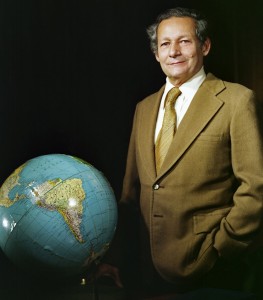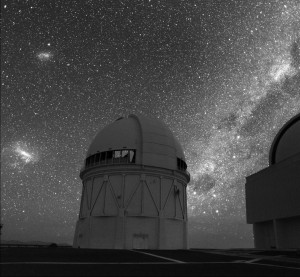Some scientists make great discoveries. Some scientists provide the opportunity for other scientists to make great discoveries. Let us now praise one not-so-famous man.
Victor Blanco assumed the directorship of the Cerro Tololo Inter-American Observatory (CTIO) in June 1967, just five months before the observatory opened. CTIO, a collaboration between U.S. and Chile, was an attempt to correct a grievous astronomical oversight: the skies of the Southern Hemisphere. Prior to CTIO, the number of observatories in the Northern Hemisphere was 88, and the number of observatories in the Southern was 10. The disparity in the quality of observing conditions, however, was even more pronounced. The number of Southern Hemisphere observatories with both frequent clear night skies and exceptional “seeing,” as astronomers call atmospheric conditions, was zero.
When surveyors began scouting for a site for CTIO, they already knew that the Atacama desert, in northern Chile, was one of the world’s driest, meaning that astronomical observations would be relatively free of distortions caused by moisture in the atmosphere. But they found that the desert air was unusually stable, too, due to a semi-permanent high pressure system. They settled on Cerro Tololo, a 2200-meter high mountain in the southern part of the desert, about 80 kilometers east of the coastal town of La Serena.
Blanco was born in 1918 in Puerto Rico. As a child, he earned money by raising pigs, which he named after asteroids—Ceres, Vesta, Ganymede. Before he accepted the directorship of CTIO, he had served as an astronomer at the Case Institute of Technology (now Case Western) and the U.S. Naval Observatory. At CTIO, however, he found that he had to be more than an astronomer, even more than an administrator. He needed to be a diplomat.
When the Marxist Salvador Allende won the Chilean presidential election in September 1970, Blanco learned that U.S. sponsors were reluctant to risk further resources on a project operating under an anti-U.S. leadership. So Blanco traveled to Santiago, met with Allende himself, and received promises of the president-elect’s complete support. During the severe economic and political crises that followed, Blanco later wrote, “not a single observing night was lost.”
Three years later, a military coup overthrew Allende (and Allende died, under somewhat mysterious circumstances), putting Augusto Pinochet in power. Once again Blanco headed to Santiago, and once again he had a face-to-face encounter with a new national leader. Although this meeting was less immediately reassuring, it was ultimately just as effective. “In La Serena, apart from some executions that took place soon after the overthrow of Allende, relative calm prevailed,” Blanco wrote. “Only one or two observing nights were lost.”
 “Victor was like a father to the CTIO staff—both Chilean and U.S. hires,” astronomer Mark Phillips recently told me. In 1978, a longstanding dispute between Chile and Argentina over ownership of several islands near the Beagle Channel, at the southern tip of South America, reached the brink of war. Yet again Blanco had to summon skills beyond the job description of a typical observatory director. “Victor called a meeting of all observatory personnel to discuss the conflict,” Phillips said, “and managed to calm us all down.”
“Victor was like a father to the CTIO staff—both Chilean and U.S. hires,” astronomer Mark Phillips recently told me. In 1978, a longstanding dispute between Chile and Argentina over ownership of several islands near the Beagle Channel, at the southern tip of South America, reached the brink of war. Yet again Blanco had to summon skills beyond the job description of a typical observatory director. “Victor called a meeting of all observatory personnel to discuss the conflict,” Phillips said, “and managed to calm us all down.”
Blanco resigned from CTIO in 1980, but his commitment to Southern Hemisphere astronomy has continued to pay off. In 1987 a supernova bloomed directly overhead, cosmologically speaking, in the Large Magellanic Cloud. The LMC, a satellite galaxy to our own Milky Way, is not visible at all from most of the Northern Hemisphere, but you can see it from Cerro Tololo—even with the naked eye—every clear night all year round. The supernova initiated what quickly became a scientifically extraordinarily rich worldwide viewing party, with Phillips and a recent hire, Nicholas Suntzeff, assuming the role of what they facetiously called “the local supernova experts.”
A few years later, Phillips (who eventually became one of Blanco’s successors as CTIO director, and is now the associate director of the Las Campanas Observatory, also headquartered in La Serena) developed a method that allowed astronomers to calibrate a particular type of supernova as a standard candle—an object of standard luminosity that astronomers can use to measure distances. That innovation allowed Phillips, Suntzeff (now at Texas A&M), and other collaborators at Cerro Tololo, as well as at Cerro Calán, to survey “nearby” supernovae. Those measurements in turn became a key stepping stone for two rival teams of astronomers (one of which included Phillips and Suntzeff) that observed cosmologically far more distant supernovae, often using telescopes at Cerro Tololo. Those measurements in turn led the two teams to conclude that the expansion of the universe is speeding up under the influence of “dark energy.”
In 1967, when Victor Blanco became the director of Cerro Tololo, nobody could have foreseen the explosion of a naked-eye supernova in a galaxy visible primarily from the Southern Hemisphere. Nobody could have foreseen the discovery of evidence for dark energy. Probably nobody could have even foreseen the emergence of Chile as an astronomical powerhouse to rival any nation in the north, as international observatory after international observatory has blossomed in the preternaturally dry and stable desert air. But sometimes that’s what happens when someone with a vision takes a flyer on science: more science.
On September 8, 1995, the CTIO 4-meter telescope was dedicated to Victor M. Blanco. On March 8, 2011, Blanco died. He was 92.
* * *
Upper image: Blanco the telescope. At left are the Large and Small Magellanic Clouds, at right the Milky Way. The only source of illumination in the photograph is starlight. It was taken with a 2048 x 2048 CCD usually used on the telescope but here mated to a Zeiss Distagon 40 mm f/4 lens by a “camera body” made in house. For fun, click on the image, enlarge, and look through the observatory “window” for even more stars. Credit: Roger Smith/NOAO/AURA/NSF.
Lower image: Blanco the man. For fun, go to the NOAO website and ask yourself what’s wrong with this picture. Credit: P. Marenfeld (NOAO/AURA/NSF). (Update: They fixed it. When this post first ran, the photo at NOAO.edu was transposed, so that South America, as Jessa bemusedly notes in the Comments below, was backward east-to-west.)
Some of the information in this post comes from articles Victor Blanco wrote for the National Optical Astronomy Observatory in 1993 and the Annual Review of Astronomy and Astrophysics in 2001.

I’ve never heard of Blanco and I’ve written about this stuff for centuries. Thank you for introducing us. What a good guy. And that picture is GORGEOUS — the little galaxies hanging around outside our big one.
Haha — congratulations, Florida, you are now in the Pacific.
Thank you for sharing with us!
My pleasure–truly.